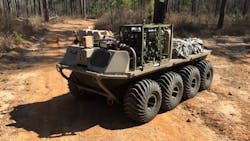Army asks General Dynamics to design unmanned combat vehicle for battlefield cargo in $249 million contract
WARREN, Mich. – U.S. Army combat vehicle experts needed an unmanned ground vehicle (UGV) able to carry about 1,000 pounds of equipment to reduce the burden of nine soldiers across an infantry squad. They found their solution from General Dynamics Land Systems in Sterling Heights, Mich.
Officials of the Army Contracting Command at Detroit Arsenal in Warren, Mich., announced a $249 million five-year contract Wednesday for the first increment of the Small Multipurpose Equipment Transport (S-MET) program.
The S-MET vehicle from General Dynamics is to be based on the company's Multi-Utility Tactical Transport (MUTT) UGV, an eight-wheel battlefield cargo carrier that should be able to operate autonomously, by remote control, or by following a soldier-mounted beacon.
General Dynamics prevailed originally in the S-MET competition in October 2019, but the project was recompeted after Textron Systems in Providence, R.I., protested the award. Textron had teamed with Howe & Howe Technologies Inc. in Waterboro, Maine, to enter the Grizzly UGV in the competition.
The General Dynamics S-MET unmanned vehicle will provide not only cargo-carrying capability, but also power generation for recharging batteries and powering modular mission payloads. The idea is to help infantry move faster, farther, and with less exhaustion.
The S-MET will modernize the Army’s inventory of robots to provide infantry brigade combat teams with a robotic mule capability, Army officials say. The S-MET enables warfighters to conduct unconstrained movement without excessive physical burden on the battlefield.
The General Dynamics S-MET will be an unmanned and optionally manned system able to carry 1,000 pounds; move more than 60 miles over three days; and generate three kilowatts of power while stationary, and one kilowatt while moving.
Army leaders plan to field the S-MET as early as 2022, and complete fielding of 624 SMET UGVs by early 2025. The Army also will supervise development of modular mission payloads for the S-MET to enhance system capability.
Related: Aurora moves forward with project to develop unmanned helicopter for battlefield resupply
The General Dynamics MUTT can operated as a controllerless small-unit robotic follower, or as a remote-controlled or teleoperated teammate. It is designed to accommodate new controllers and increased levels of autonomy as Army requirements change.
The eight-wheel MUTT (four wheels on a side) can carry as much as 1,200 pounds, weighs 3,000 to 3,500 pounds, is about 10 feet long and six feet wide, and has a maximum range of 60 miles.
On this contract General Dynamics will do the work at locations to be determined with each order, and should be finished by July 2025. For more information contact General Dynamics Land Systems online at www.gd.com/our-businesses/combat-systems/land-systems, or the Army Contracting Command-Detroit Arsenal at https://acc.army.mil/contractingcenters/acc-dta.

John Keller | Editor-in-Chief
John Keller is the Editor-in-Chief, Military & Aerospace Electronics Magazine--provides extensive coverage and analysis of enabling electronics and optoelectronic technologies in military, space and commercial aviation applications. John has been a member of the Military & Aerospace Electronics staff since 1989 and chief editor since 1995.

